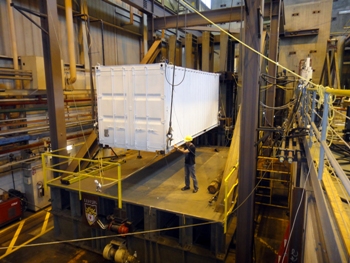Feb 6 2013
Anyone who has seen the movie "Impossible" or watched footage from the Japanese tsunami has learned the terror that can strike with little warning. In those cases, when there is no time to flee, there may still be time to reach higher ground, called vertical evacuation.

But as you race to the third floor, how do you know if the building will hold up? Walls of water are not the only danger. Another potentially lethal challenge is water-driven debris - such as 60,000-pound fully loaded cargo containers - transformed into projectiles. Often pulled behind semi-trucks on highways, these containers that line port areas well exceed the telephone-pole-size 1,000-pound default log assumed by most U.S. building-design guidelines.
A multi-university team lead by Ronald Riggs, a structural engineer at the University of Hawaii, has determined just what the impact could be and will present findings at an international conference in June. The goal is to supply structural engineers with information to design buildings in areas vulnerable to tsunamis.
Currently there are no scientifically tested guidelines. And, as those who survived the Japanese tsunami that swept thousands to their deaths can attest, no one had planned for such force.
"Most structural systems are designed to defy gravity, not a side kick from a shipping container," Riggs says. "An engineer can build what it takes to withstand the karate chop, but first the engineer has to know what forces to expect."
This knowledge is vital not only for the buildings into which people might flee, but also for coastline storage tanks that could spew chemicals or other pollutants if damaged.
Riggs first began thinking about the problem as he examined damage to bridges and buildings following Hurricane Katrina. He noticed the cargo containers and barges that had been flung onto land in areas such as Biloxi, Miss. On another scientific excursion to Samoa, he says he saw a shipping container "whacked against a meeting hall - and there was no port anywhere nearby."
"These shipping containers are surprisingly ubiquitous," Riggs says. The point was further brought home on TVs across the world that played and replayed footage from Tohoku, Japan, as tsunami-fed waters dragged cars, trucks and shipping containers as much as six miles inland and then back out to sea in the drawdown.
"They may have been moving only about 10 miles an hour, but given their weight, this is a significant load for a structure not made for it."
His colleagues and he proposed research to analyze several pieces of the puzzle with the help of the George E. Brown Jr. Network for Earthquake Engineering Simulation (NEES), a distributed laboratory with 14 sites across the country funded by the National Science Foundation. The network, which also funded Riggs' research, provides access to highly specialize, sophisticated and expensive equipment.
For Riggs, two NEES sites were needed. One is at Lehigh University in Bethlehem, Pa., which specializes in real-time multi-directional testing for earthquake simulation of large-scale structural systems. The other is a wave flume longer than a football field at the Tsunami Research Facility at Oregon State University. At the Lehigh site, they swung full-scale wooden poles and shipping containers through the air on a pendulum to determine the force of impact at various velocities. At Oregon State, they ran similar tests at a 1:5 scale, but this time in its large flume wave to see if that made a difference.
His basic assumptions held true, but there were two surprises. First, when the speed of the projectile was the same, the water did not have a significant impact.
"We thought the fact that it was in water would increase the load, but it did not, at least not substantially," Riggs says. "The impact is so short, on the order of a few milliseconds, that in some ways the water doesn't have time to increase the force."
The second surprise was that the weight of the shipping container's contents also did not matter as much as he would have expected. The container itself, which is roughly 20 feet long and weighs about 5,000 pounds empty, could weigh as much as 60,000 pounds when fully loaded. Yet, its load when striking a building was not significantly greater than that of the empty container.
The reason is the same as for the water, Riggs says.
"Unless the contents are rigidly attached to the frame of the container, which they usually are not, the contents also don't have time to increase the force during the very short duration of impact."
The next step for Riggs and his team is to use the preliminary findings to better define building guidelines and policy.
"It's especially important for areas like Japan and the Cascadia area on the West Coast of the United States where tsunamis are most likely to strike with little warning, making vertical evacuation essential," Riggs says. "Or in Waikiki where the population density would make horizontal evacuation (trying to outrun the tsunami) problematic."
Riggs will present the team's findings at the 32nd International Conference on Ocean, Offshore and Arctic Engineering, sponsored by the Society of Mechanical Engineers ASME to be held June 9-14 in Nantes, France. His colleagues are Clay Naito, associate professor at Lehigh University; Dan Cox, professor at Oregon State University; and Marcelo Kobayashi, associate professor at the University of Hawaii.